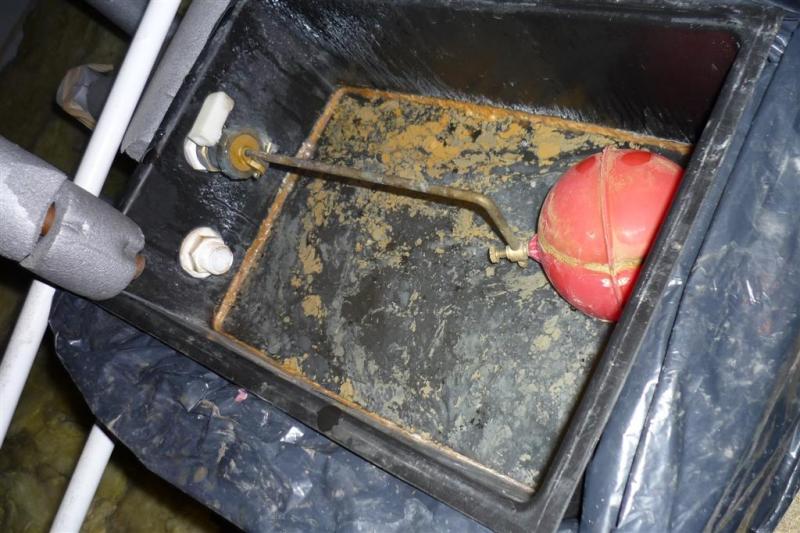Hello everyone
My parents have a wall-hung Ideal Classic RS250 boiler as part of an open vented system. For quite few months it has been making 'flushing' and 'gurgling' noises.
The boiler downstairs in a utility room, hung on an external wall with a horizontal flue passing through the wall. There is an filling & expansion tank in the loft. On the floor below the tank's location is an airing cupboard containing a hot water tank and the central heating pump (and associated pipework). The pump is a Grundfoss Selectric 15-50 set to speed position 2. There is also a Honeywell three-way valve.
The noises occur when the heating and hot water come on, especially in the morning. When the hot water comes on, a trickling/gurgling noise can be heard from the pipework going into the top of the boiler.
When the heating comes on there is a loud flushing/bubbling noise from the airing cupboard and bubbles can be heard flowing into an adjacent bedroom radiator.
There are 12 radiators in the house with a total output of 8000 watts. This includes a towel rail in the main bathroom. The three bedroom radiators are fitted with Aladdin automatic air-release valves. All the radiators are regularly checked for air, but none is found, water drains out as soon as the key is turned. The bleed valve in the airing cupboard is checked too, but no air or gas comes out that one either. The radiators seem to be hot all over, I can't feel any cold spots.
I went into the attic and checked the f&e tank and it has a lot of sludge in it and the water is murky.
The heating system is approx 12 years old (installed when the house was built) and was powerflushed by a Corgi registered heating engineer in summer 2009 (my father wanted this done as a precautionary measure). I do not believe there have been any problems with the system before, it has never suffered any breakdowns.
In march this year, two radiators were replaced with double convectors and the system was drained in the process. This was a DIY installation, I assisted my father, we drained the system and I completely emptied the f&e tank in the attic and cleaned it of any sludge deposits, (I don't think the heating engineer who did the powerflush cleaned the tank).
We poured buckets of clean water into the tank until the the water drained clear, and refilled the system, adding two 1-litre bottles of Sentinel X100 via the f&e tank. All radiator valves were checked to release air and the valve in the airing cupboard.
Sorry for the very long post , I have tried to cover everything that may explain the situation.
, I have tried to cover everything that may explain the situation.
More pics are in my gallery
Thanks in advance
Paul
My parents have a wall-hung Ideal Classic RS250 boiler as part of an open vented system. For quite few months it has been making 'flushing' and 'gurgling' noises.
The boiler downstairs in a utility room, hung on an external wall with a horizontal flue passing through the wall. There is an filling & expansion tank in the loft. On the floor below the tank's location is an airing cupboard containing a hot water tank and the central heating pump (and associated pipework). The pump is a Grundfoss Selectric 15-50 set to speed position 2. There is also a Honeywell three-way valve.
The noises occur when the heating and hot water come on, especially in the morning. When the hot water comes on, a trickling/gurgling noise can be heard from the pipework going into the top of the boiler.
When the heating comes on there is a loud flushing/bubbling noise from the airing cupboard and bubbles can be heard flowing into an adjacent bedroom radiator.
There are 12 radiators in the house with a total output of 8000 watts. This includes a towel rail in the main bathroom. The three bedroom radiators are fitted with Aladdin automatic air-release valves. All the radiators are regularly checked for air, but none is found, water drains out as soon as the key is turned. The bleed valve in the airing cupboard is checked too, but no air or gas comes out that one either. The radiators seem to be hot all over, I can't feel any cold spots.
I went into the attic and checked the f&e tank and it has a lot of sludge in it and the water is murky.
The heating system is approx 12 years old (installed when the house was built) and was powerflushed by a Corgi registered heating engineer in summer 2009 (my father wanted this done as a precautionary measure). I do not believe there have been any problems with the system before, it has never suffered any breakdowns.
In march this year, two radiators were replaced with double convectors and the system was drained in the process. This was a DIY installation, I assisted my father, we drained the system and I completely emptied the f&e tank in the attic and cleaned it of any sludge deposits, (I don't think the heating engineer who did the powerflush cleaned the tank).
We poured buckets of clean water into the tank until the the water drained clear, and refilled the system, adding two 1-litre bottles of Sentinel X100 via the f&e tank. All radiator valves were checked to release air and the valve in the airing cupboard.
Sorry for the very long post
More pics are in my gallery
Thanks in advance
Paul











